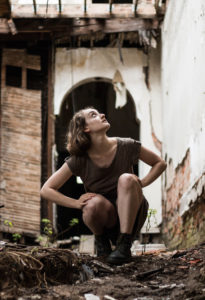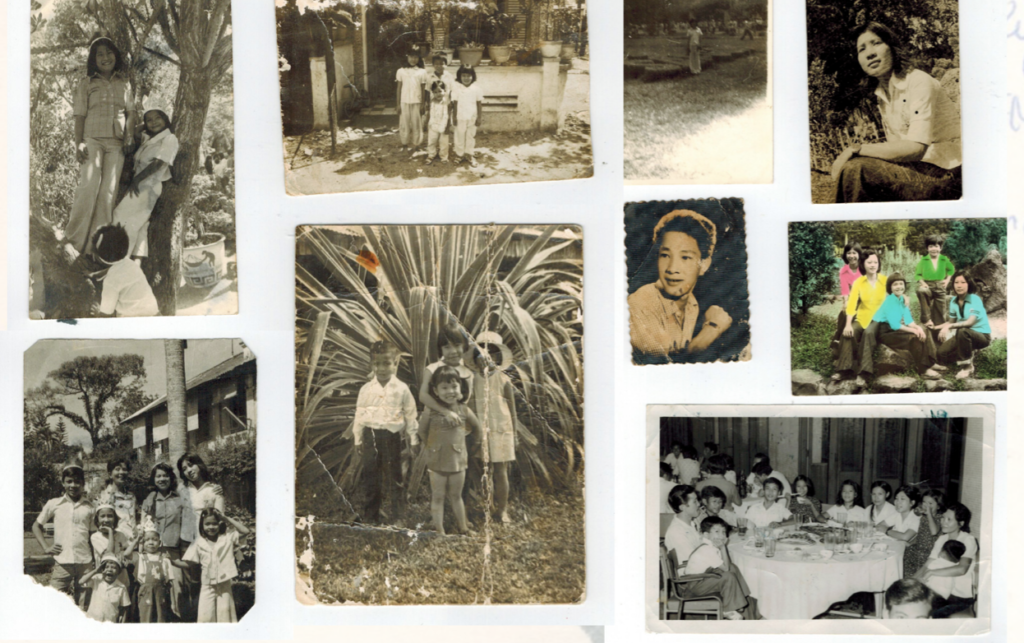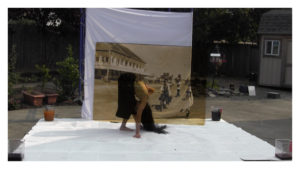
Introduction
Hallie Chametzky and Sarah Nguyen are archivist dance-makers who met at the Mark Morris Dance Group Archives, where Sarah was working and Hallie was visiting, in the fall of 2019. Since then, they have worked together at Dance/USA where Hallie is the Archiving Specialist and Sarah is a 2020/2021 Archiving & Preservation Fellow working with AXIS Dance Company. Their shared interest in how legacy, memory, materiality, and the sharing of information inform them as movement artists brings them together in this forum. What follows is a series of musings on how their relationship to making and thinking about dance and performance is intertwined with their professional archiving practices.

Who are we? Why are we talking about dance & archives?
Hallie Chametzky: While studying dance and choreography in college, I was selected for a Fellowship in the dance collections at the Library of Congress. That was my crash course training in archives—processing and making available materials from the Martha Graham Legacy Project. It blew my mind that I was able to get up close and personal with materials that belonged to modern dance icons and had hardly been handled since the early-to-mid-twentieth century. I worked a lot with papers related to the New Dance Group, who I consider my dancestors because of their radical, socialist, egalitarian approach to concert dance. I kept applying to dance archives gigs, which are fairly few and far between, and I’m now really lucky to work for Dance/USA, where I offer archives education, resources, and services to living, working artists, especially those who have been historically marginalized in the dance world and the archival record.
I wanted to talk about dance making and archiving work with you, Sarah, because I haven’t met many archivists who also have an ongoing movement practice, and I’m curious about the ways you see those two worlds colliding. If my artist brain and my archivist brain were a venn diagram, there would be a big overlap in the middle, but also some space on the sides. I also saw your piece 30 x 3 virgin remy: $200 OBO recently, and I could see how memory, history, and the body are intertwining for you.
Sarah Nguyen: I’m excited you saw my piece, Hallie! It was the first time I presented a work that’s directly about my ancestors, so it felt vulnerable yet healing. As an information science researcher and dancer, I’m interested in how lived experiences turned memories can translate to artful movement. I started to explore this idea when I started my Masters in Library and Information Science program and processed and digitized records for the Mark Morris Dance Group Archives.
I grew up in studio competition dance so I never really considered myself a dance artist; it felt too formulaic, commercial. But when I interned at Luna Dance Institute library, I was introduced to critical inquiry and creative movement, which broadened my understanding of the mutable boundaries of dance. Now that I’ve been a Dance/USA Archiving Fellow for AXIS Dance Company’s archives for two years, I’ve come to accept myself as both a researcher and creator of movement and information. Seeing your work, Hallie, Songs for Women, Songs for Men, I’m fascinated to learn more about your experience integrating archives into your dance practice.
What is your relationship with the concept of the “body as archive” or the more general increased interest in “the archive” by movement artists?
SN: For me, the term “archive(s)” in relation to body and movement artists is an exploratory fifth dimension intersecting information, memory, and the tangible physical body in one space. It’s not a new concept or method, but the nuances that differentiate information and memory on the physical body versus on visual or text documentation is often overlooked. After years of research and practice in information organization and dance, I look at what it means to create dance as my body ages and then share these creations for public access. Four different influences come to mind with this question:
First, there’s Tonia Sutherland’s archival research, which looks at how archives and memory can be preserved through non-print mediums. Sutherland focuses on dance and stories passing through generations of Pacific Islander and Black communities. In particular, her work explores Dunham Technique vocabulary as a means to decolonize archival praxis[1], the impact of digital records on Black bodies[2], and Black communities’ use of digital social media as a means to create performative, autonomous, and liberatory spaces.[3] Her perspectives on the violence that existing archives have had on oppressed bodies resonate with me as I navigate through misrepresentation and undocumentation of my ancestors.
Then there’s the choreographic workshop that David Roussève, director of David Roussève/REALITY, taught in preparation for his New York premiere of Halfway to Dawn,[4] where we learned about Roussève’s process incorporating archival documents of the politically active jazz artist, Billy Strayhorn, into movement and onto the stage. It was the first time I experienced intentional archival references in a class/rehearsal space and saw how dancers can re-interpret a choreographer’s intellectual embodiment of archival records. I was inspired by the dancers’ ability to uplift marginalized souls and voices and weave in the “past, present, and fantasy”, as they created relationships with each other, the music, and quotes from Strayhorn’s diary entries on stage.
Third, I think of Kathy Carbone’s research on activating archival materials. She re-imagines archival documents to commemorate the lives of the original creators and subjects of the archive,[5] a way to better understand, represent, and re-describe the intentions of a record outside of the colonial perspective that has been traditional to archival practices.
Last, there’s a the concept of “jazz time,”[6] which posits that music, dance, and lived experiences are never compartmentalized or segregated from each other. Instead, lived experiences are interwoven throughout the past, present, and future of individuals’ memories, movement creations, and daily life. This places value in the often forgotten care and maintenance needed to address traumas and narratives stored within archives, especially when we look at sustainability of born-digital records, such as those created by artists and hosted/published on third-party proprietary platforms owned by Big Tech companies.
HC: I feel that there is real truth to the idea that we are repositories for knowledge that we can pursue through movement, ritual, and embodiment. In a totally different (and maybe more concrete) vein, I’m torn about other ways that I’m seeing “archive” used in the performance world. On the one hand, I’m delighted that more artists are considering their bodies and movements as part of a lineage. I’m all for expanded notions of the archive, especially because “the archive” has been controlled for far too long by institutional, colonial forces.
On the other hand, there are also artists who claim to be “archiving” their work by curating selections of pieces and processes on social media or YouTube. Without being too critical, I cringe a bit at the self-proclaimed artist-archivists who think that videoing and sharing their work is by default an archival process. Social media websites claim a level of copyright ownership over the posts shared on them. They are fully within their right to use posts shared by users however they wish, including removing them from the site completely. What kind of archive has so little control over its materials? An archive that isn’t concerned with who is granted ownership of the materials or whether they disappear without notice would be a sloppy archive indeed. Considering the ethics of the platform by which you share information is an essential part of responsible archiving, but it’s not very sexy. It’s easier to think of “the archive” as simply any collection of interesting stuff.
There’s a difference between conceptual ideas of the “body archive” and this sloppy internet archive I’m complaining about. But both seem to come from the same place of increased interest among dance artists in participating in and creating lineage and history. If artists wanted to, say, establish a digital guerilla archive where they can share and preserve work outside of a traditional institutional context, I would be their number one fan. It’s all about caring for the materials, which involves an entirely different sort of labor than curating a social media page.

How does your archival practice show up in your dance making and vice versa?
HC: I tend to be a structural choreographer; the form or arc of a dance comes to me before the details of the movement. I find that so much of building, maintaining, and understanding the archive is the same in that one has to get this broad, overarching feel for the narrative of the materials before getting too involved with details. I enjoy going on a detective hunt to identify a mysterious face in a blurry photograph, but without understanding the full scope of the materials and building the containers and categories that contextualize them, it can be self-defeating to get bogged down in those minute details. No one object in the archive is distinct; context and interrelationships are key to our understanding. The same is true for me in making a dance. No one movement exists as a discrete action. The arc of the piece has to make sense to me before I can get hung up on specific gestures or phrases. And before I can shape the structure of the piece I have to do my deep research and learning, which often includes study of history, texts, and the archive. So it’s a big cycle.
Songs for Women, Songs for Men came out of my thoughts on sacred and secular gendered ritual acts, and how ritual can be both a tool of liberation and oppression. The title is taken directly from the title of a dance by Sophie Maslow whose archival papers I processed at the Library of Congress. Maslow’s dances dealt a lot with Jewishness, as do mine, and I liked the idea of following the Jewish tradition of naming after the dead. The piece uses archival Hebrew and Yiddish music, and also features archival recording of my grandmother, the late poet Anne Halley, reading her poems.
I made this piece in an academic context and received quite a bit of feedback from my teachers and peers that was critical of how difficult it was to understand portions of the poems because of the quality of the archival audio. I was frustrated and baffled by this as someone who delights in the fundamental incompleteness of both live performance and the archival record.
I don’t believe I’m entitled to an experience of live performance which leaves me with clarity. Live dance is created in the gap between the audience and the performer(s). Similarly, the archival record is composed of more gaps and silences than pieces of knowledge and information. Our contemporary bodies encountering an archive are not owed total understanding. The intimacy generated by encountering archival materials is entirely one-sided; the contemporary party voyeuristically projects meaning and significance onto materials that have been curated by the whims and preferences of time. It’s crucial that we all have the ability to feel grounded in legacy and history. We must insist upon new, anti-colonial models for equitable archiving so that the legacies of Black people, Indigenous people, and other people who have historically been excluded from archival record and practice can connect with legacy materials in the ways white people have long had access to.[7] Still, I believe that none of us are owed a comprehensive, uncomplicated picture of any person or event from the past. Our ancestors were just as complex and multilayered as we are, and our encounters with archives cannot ever give us access to their full personhood, even as they can offer profound connection to legacy and history. I am arguing for privacy for the dead, even as I work in a field which offers access to their materials—another gray area which I hope to activate in my creative work.
SN: Ugh, your piece and description is so beautiful, Hallie. It reminds me of the idea that there is no such thing as a neutral archivist or archives and each viewer brings in their own biases and relationships that shape the narrative. In contrast, my recent work is more about creating archives for the stories that have been traditionally invisibilized by institutional archives, so my intentions are to center the underserved voices even if they don’t follow “archival best practices.”
In September 2020, a few personal life events happened in the midst of the pandemic and heightened social inequalities: I graduated from a Masters in Library and Information Science program, I moved from New York City back to the West Coast, and I started an Information Science PhD program (first generation in my family). Also, I’d been growing out my long, pin straight, thick, black, virgin (no chemicals) and remy (cut and tied in its natural direction) hair for a decade and it was time to cut it. In light of these moments, I conjured an experimental dance film in preparation to shave my hair and start fresh. This is the contemporary history that motivated the dance film you saw in March 2020, 30 x 3 virgin remy: $200 OBO.

Inspired by Jeff Friedman’s research on oral histories and “time consciousness and embodied communication,” I recorded an oral history with my mother about her life as a six-year-old in rural Vietnam during 1972-1974. Her memories navigate her auntie’s long hair, how it symbolized luxury and malevolence, even though her auntie was the only family member who accepted her parents’ forbidden mixed Teochew and Vietnamese marriage. After my mother’s father was imprisoned by the Communist party and her mother was banned from bringing her mixed heritage children into her parents’ home, my mother’s auntie generously took my mother and her siblings in to live and work on her farm. In collaboration with musician and video artist, Ramin Rahni, we created movement and music following the story’s disjointed narration that is common to many immigrants’ storytelling of past traumas. After more than 45 years, this was the first time my mother was comfortable recalling and sharing these fragmented memories, similar to the complex and multilayer identities you mentioned, Hallie.
To accompany the oral history, we browsed Library of Congress catalogs, Internet Archive, and other homegrown online libraries to pull inspiration from Vietnam specific musical instruments, dance, apparel, and imagery. It was disappointing to find the majority centered images from a U.S. soldier’s perspective, exoticization of Vietnamese villagers, or tropical tourism. Luckily, I had access to old family albums. I digitized and incorporated these paper ephemera into the dance film.
Similar to what you said, Hallie, there’s much labor and context involved in building an archive; I had to do the tedious labor to situate the context of my mother’s budding archive and set up a stable 3-2-1 backup plan — the foundational backup strategy that any person concerned with preservation should follow. In short, 3-2-1 means creating three copies of the object to be preserved, saving each copy in three different locations, saving one copy for daily access, and the other two for longer term storage.
Existing archives do not represent my Vietnamese American experience, so I create dance using archival materials as a means to regenerate memories as a reimagined creative space, moving through and with trauma without letting the sorrow overpower potential joys and justices in life.
[1] Sutherland, Tonia. 2019. “Reading Gesture: Katherine Dunham, the Dunham Technique, and the Vocabulary of Dance as Decolonizing Archival Praxis.” Archival Science 19(2): 167–83. https://doi.org/10.1007/s10502-019-09308-w
[2] Sutherland, Tonia. 2017. “Making a Killing: On Race, Ritual, and (Re)Membering in Digital Culture.” Preservation, Digital Technology & Culture 46(1): 32–40. https://www.degruyter.com/document/doi/10.1515/pdtc-2017-0025/html
[3] Sutherland, Tonia. 2019. “Social Media and the Black Travel Community: From Autonomous Space to Liberated Space.” http://scholarspace.manoa.hawaii.edu/handle/10125/59657
[4] https://www.bam.org/dance/2018/halfway-to-dawn
[5] Carbone, Kathy Michelle. 2017. “Artists and Records: Moving History and Memory.” Archives and Records 38(1): 100–118. https://doi.org/10.1080/23257962.2016.1260446
[6] The concept of “jazz time” was brought up during a series of classes with Nia-Amina Amor, movement artist and educator (https://velocitydancecenter.org/artists/nia-amina-minor/), during the Seattle Festival of Dance + Improvisation 2021 summer series. Their workshop series was titled “The Move: Experiments from Inside the Groove” where we explored the history of Black social dance, jazz, and rhythm through movement of our bodies.
[7] Those already doing this work include Jarrett. M Drake, Anthony W. Dunbar, The Indigenous Archives Collective, Lotus Norton-Wisla, Miranda Belarde-Lewis, Ricky Punzalan, Temitope Odumosu, Plateau Peoples’ Web Portal, Michelle Caswell, and many more.
This article appeared in the Fall 2021 issue of In Dance.

